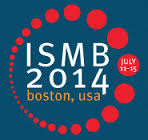 Recently, over 1,300 scientists converged in Boston to network, learn, and collaborate. They were there to attend the Intelligent Systems for Molecular Biology (ISMB) conference, July 11-15th, which is hosted by the International Society for Computational Biology (ISCB). ISMB has become the world’s largest bioinformatics/computational biology conference, attracting life scientists from around the world who are dedicated to the advancement of biological discovery through computation. The conference agenda was filled with talks covering sequence analysis, comparative genomics, gene regulation and transcriptomics, systems biology, databases and data integration, text mining and information extraction, and human health.
Recently, over 1,300 scientists converged in Boston to network, learn, and collaborate. They were there to attend the Intelligent Systems for Molecular Biology (ISMB) conference, July 11-15th, which is hosted by the International Society for Computational Biology (ISCB). ISMB has become the world’s largest bioinformatics/computational biology conference, attracting life scientists from around the world who are dedicated to the advancement of biological discovery through computation. The conference agenda was filled with talks covering sequence analysis, comparative genomics, gene regulation and transcriptomics, systems biology, databases and data integration, text mining and information extraction, and human health.
The conference started by honoring Gene Myers with the 2014 ISCB Accomplishment by a Senior Scientist Award which recognizes luminaries in the fields of computational biology and bioinformatics. Myers is known for developing the BLAST algorithm and his work on using shotgun sequencing at Celera Genomics. In his talk titled “DNA Assembly: Past, Present, and Future” he spoke about the whole genome assembly approach he and his team used at Celera. He also cited how demand for lower cost sequencing has hampered progress on the production of high-quality de novo genome reconstructions. He expressed his renewed interest in assembly using long-read sequencers.
Dana Pe’er, Associate Professor, in the Department of Biological Sciences at Columbia University spoke on “A Multidimensional Single Cell Approach to Understand Cellular Behavior.” One of her primary interests is the study of biological networks in single cells using mass cytometry which she considers a major game changer to the understanding of cellular heterogeneity. As part of her studies, she hopes “to reframe development not as a set of discrete cell types, but rather as a continuum, a dynamic process in which one can place each individual cell along a developmental trajectory that represents not only cell types, but their many intermediates.” She showed how this approach could differentiate cancer cell populations from healthy populations in novel and robust ways, and she plans to apply her studies to cancer and the improvement of personalized cancer therapy.
Continuing to show how computational approaches have advanced biological discovery was Russ Altman, Professor of Bioengineering, Genetics, and Medicine, and Computer Science at Stanford University. In his talk, titled “Informatics for Understanding Drug Response at All Scales,” he discussed his work on studying drug responses at multiple scales, including molecular, organism, and population responses. An understanding of drug action at multiple levels is necessary, he said, to understand the optimal use of existing drugs and identify new opportunities for therapeutics. He concluded that informatics can be good for inferring and ranking side effects, characterizing gene-drug interactions through text mining, predicting gene expression based on a drug’s chemical structure, and using 3D protein structures to predict fragment binding. The hope is that all this information will lead to a better understanding of personalized medicine, drug interactions, and drug repurposing.
ISMB was a great reminder of how far we’ve come in the application of computational approaches to biological discovery. At DNAnexus, we continue to work closely with the scientific community in bringing together the power of cloud computing with the science of genomics to further advance the promise of more personalized approaches to healthcare.

.png)
.png)
.png)